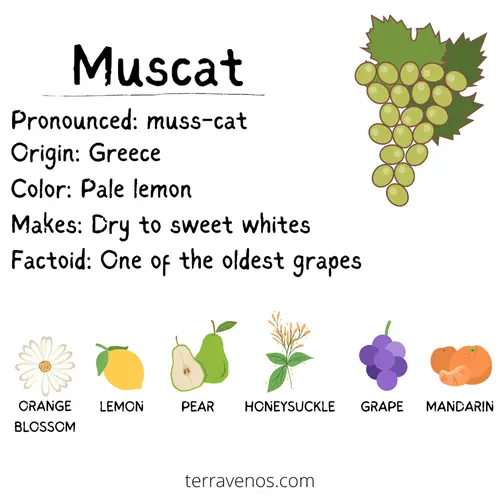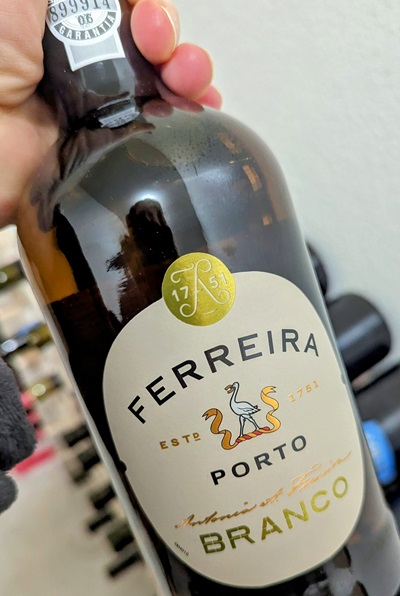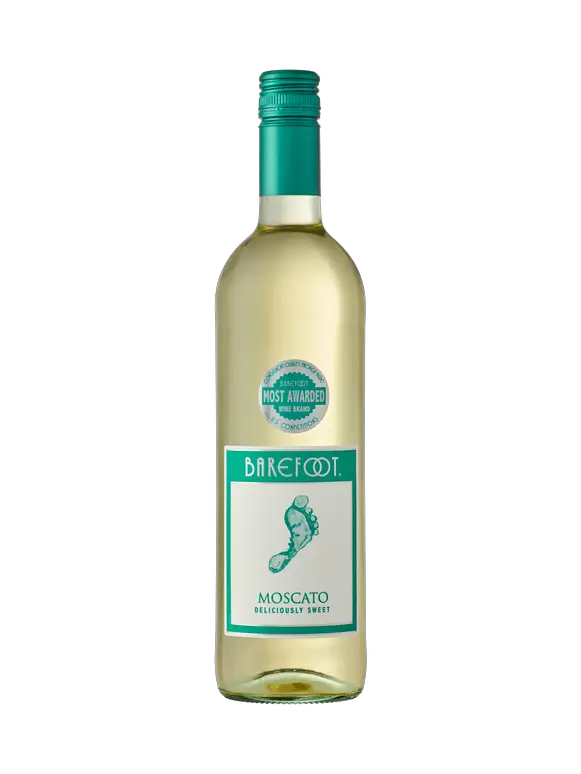Muscat is a name that refers to many different varieties of aromatic Muscat grapes (over 200). Moscato refers to a specific style of slightly sweet, effervescent Italian white wine.
Here’s what you need to know when it comes to choosing Muscat vs Moscato.
What Is Muscat Wine?

There is no grape called “Muscat”. Muscat is an ancient family of over 200 aromatic grape cultivars. Muscat wine makes dry, sweet, sparkling, and even fortified styles. Muscat delivers aromas of orange blossom, citrus, and grape.
Famous examples include:
- Muscat Blanc a Petits Grains
- Muscat Ottonel
- Muscat of Hamburg
Helpful Tip: Here’s a rundown of everything you need to know about Muscat and its many versions.
What Kind of Wine Does Muscat Make?

Muscat grapes make all wine styles:
- Dry wines
- Off-dry wines
- Sweet wines
- Semi-sparkling wines (frizzante)
- Fully sparkling wines (spumante)
- Fortified wines (Sherry and Port)
What Is Muscato Wine?

If you’re comparing Muscat and Moscato, then you’re probably thinking about the light, sweet, aromatic white wine that has a slight effervescence to it. The most famous of this style of wine is Moscato d’Asti DOC, from Italy’s northwestern Piemonte region.
Jargon Alert: DOC stands for Denominazione di Origine Controllata (literally Controlled Designation of Origin), which is a demarcated region where a wine style comes from in Italy. Here are all of the Italian wine classifications explained (just in case you’re curious).
Moscato d’Asti, or just Asti, is made from the most perfumed and aromatic cultivar of Moscato called Moscato Bianco, or Muscat Blanc a Petit Grains.
What Does Moscato Taste Like?
Expect your Moscato wine to taste like:
- Orange blossom
- White flower
- Honeysuckle
- Grape
- Lemon curd
- Meyer lemon
- Sweet mandarin
Is Muscat the Same as Moscato?
Technically Muscat and Moscato are not the same thing. However, wine marketers and even those in the wine industry will use Muscat when referring to Moscato. It’s understood that it is talking about a sweet, aromatic, effervescent white wine.
Remember: Muscat is the broad category that refers to many different grapes in the Muscat family, and Moscato is a specific style of wine. Think of it a little like saying “Toyota” (Muscat), and then “Prius” (Moscato), which is a type of car that Toyota makes).
Muscat vs Moscato: 5 Key Differences
1 Sweetness Levels: Moscato Is Always Sweet
Moscato wines are always sweet. But not all Muscat wines are sweet. (Here’s more on why some wines are made in a sweet style).
2 Alcohol Level: Moscato Is Almost Always Low Alcohol
Moscato typically features a lower alcohol by volume (ABV), hovering around 5-7%. This results in a sweeter profile, appealing to those who enjoy a milder kick. Other wines made from Muscat, including fully sparkling wines, dry Muscat wines, and fortified wines can be 11%-22% ABV.
3 Fizzyness: Moscato Is Always Fizzy
Moscato made in the Asti style is almost always semi-sparkling, but you can find fully sparkling versions. Moscato wines will always have bubbles. Muscat wines may or may not have bubbles.
Helpful Wine Buying Tip: Want a fully sparkling Moscato? Look for Asti DOCG or Asti Spumante.
4 Grape Varieties: Moscato Bianco vs All the Others
Moscato uses the grape Muscato Bianco, or Muscat Blanc a Petit Grains, the most aromatic in the Muscat family. As mentioned above, there’s no such thing as a “Muscat Grape”; it’s a broad umbrella label.
5 Which Is More Expensive: Moscato vs Muscat?
You’ll find inexpensive to mid-priced wine Moscatos (starting around $5-$8 USD). The cost for other wines made from different Muscat grapes will depend on the growing region and winemaking style.
Moscatos are some of the most affordable wines on the market.
Final Thoughts – Muscat vs Moscato
If you’ve gotten to the point in your wine journey where you’re trying to untangle the differences between Muscat vs Moscato, you’re in excellent shape!
Remember: Muscat is a broad label; Moscato is that sweet, fizzy, low-alcohol wine you like to pour liberally on game night.
If you have access to a decent wine shop, go in and get a White Port or fully dry white wine made from Muscat along with a Moscato and do a side-by-side tasting. I think you’ll be pleasantly surprised.
Thirsty for More?
The best way to learn about different wine styles is to host DIY wine tastings. Here’s how.
Love Moscato? Here’s a list of other sweet white wines that you’ll probably enjoy, too.



